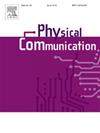On the performance of full-duplex AF relaying over α-μ fading channels
IF 2
4区 计算机科学
Q3 ENGINEERING, ELECTRICAL & ELECTRONIC
引用次数: 0
Abstract
This work investigates the performance of a full-duplex amplify-and-forward (FD-AF) relaying taking into account the residual self-interference at the relay node. We consider the - distribution as fading channel model at the two links which well describes the small scale fading in terahertz (THz) communications. Full-duplex relaying can potentially double the spectral efficiency achievable by half-duplex operation considering the detrimental effects of inevitable self-interference. We derive the closed-form expressions of rate outage probability and ergodic capacity whereas an exact expression of average symbol error probability of coherently detected M-ary phase shift keying (M-PSK) is derived using the univariate and bivariate Fox’s H-functions. The derived expressions are valid for arbitrary values of the - fading parameters. Through simulations, it has been revealed that the performance of the system improves when the relay is closer to the source node as compared to destination node. Moreover, it has been observed that the fading parameters of the source-relay link dominates the system’s performance as compared to the parameters of relay–destination link. The analytical expressions are ascertained by simulations which are found to be in excellent agreement.
求助全文
约1分钟内获得全文
求助全文
来源期刊

Physical Communication
ENGINEERING, ELECTRICAL & ELECTRONICTELECO-TELECOMMUNICATIONS
CiteScore
5.00
自引率
9.10%
发文量
212
审稿时长
55 days
期刊介绍:
PHYCOM: Physical Communication is an international and archival journal providing complete coverage of all topics of interest to those involved in all aspects of physical layer communications. Theoretical research contributions presenting new techniques, concepts or analyses, applied contributions reporting on experiences and experiments, and tutorials are published.
Topics of interest include but are not limited to:
Physical layer issues of Wireless Local Area Networks, WiMAX, Wireless Mesh Networks, Sensor and Ad Hoc Networks, PCS Systems; Radio access protocols and algorithms for the physical layer; Spread Spectrum Communications; Channel Modeling; Detection and Estimation; Modulation and Coding; Multiplexing and Carrier Techniques; Broadband Wireless Communications; Wireless Personal Communications; Multi-user Detection; Signal Separation and Interference rejection: Multimedia Communications over Wireless; DSP Applications to Wireless Systems; Experimental and Prototype Results; Multiple Access Techniques; Space-time Processing; Synchronization Techniques; Error Control Techniques; Cryptography; Software Radios; Tracking; Resource Allocation and Inference Management; Multi-rate and Multi-carrier Communications; Cross layer Design and Optimization; Propagation and Channel Characterization; OFDM Systems; MIMO Systems; Ultra-Wideband Communications; Cognitive Radio System Architectures; Platforms and Hardware Implementations for the Support of Cognitive, Radio Systems; Cognitive Radio Resource Management and Dynamic Spectrum Sharing.
 求助内容:
求助内容: 应助结果提醒方式:
应助结果提醒方式:


